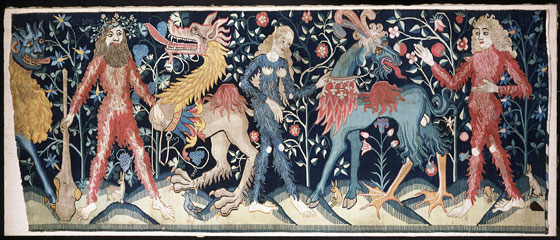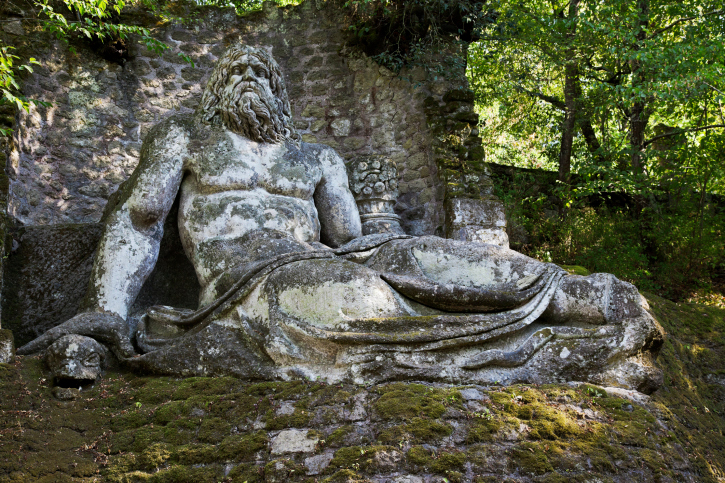 Weird Stuff
Weird Stuff  Weird Stuff
Weird Stuff  History
History 10 Times Trickery Won Battles
 Technology
Technology 10 Awesome Upgrades to Common Household Items
 Misconceptions
Misconceptions 10 Hilarious (and Totally Wrong) Misconceptions About Childbirth
 Weird Stuff
Weird Stuff 10 Warning Labels That Exist Because Someone Actually Tried It
 Health
Health Ten Confounding New Inventions from the World of Biomedicine
 Creepy
Creepy 10 Death Superstitions That Will Give You the Creeps
 Movies and TV
Movies and TV 10 Movies That Get Elite Jobs Right, According to Experts
 Weird Stuff
Weird Stuff 10 Times Real Laws Were Based on Bizarre Hypotheticals
 Animals
Animals 10 Inspiring Tales of Horses Being Human
 Weird Stuff
Weird Stuff 10 Typos That Accidentally Changed History
 History
History 10 Times Trickery Won Battles
 Technology
Technology 10 Awesome Upgrades to Common Household Items
Who's Behind Listverse?

Jamie Frater
Head Editor
Jamie founded Listverse due to an insatiable desire to share fascinating, obscure, and bizarre facts. He has been a guest speaker on numerous national radio and television stations and is a five time published author.
More About Us Misconceptions
Misconceptions 10 Hilarious (and Totally Wrong) Misconceptions About Childbirth
 Weird Stuff
Weird Stuff 10 Warning Labels That Exist Because Someone Actually Tried It
 Health
Health Ten Confounding New Inventions from the World of Biomedicine
 Creepy
Creepy 10 Death Superstitions That Will Give You the Creeps
 Movies and TV
Movies and TV 10 Movies That Get Elite Jobs Right, According to Experts
 Weird Stuff
Weird Stuff 10 Times Real Laws Were Based on Bizarre Hypotheticals
 Animals
Animals 10 Inspiring Tales of Horses Being Human
10 Bigfoot-Type Cryptids You May Not Know About
The whole world has heard of Bigfoot and the Abominable Snowman (known to the locals as the Yeti), but how many people know that almost every country has its own version of the ape-man legend? The persistent quality of these legends and their appearance in so many different cultures have some believing they indicate small populations of prehistoric hominids who have somehow survived all this time, or possibly an as-yet-undiscovered ape species. As we shall see, some have even stranger explanations.
10The European Wildman

European folklore is rife with tales of the “Wild man of the Woods.” They were so common that medieval heraldry often included depictions of the furry Wildmen. Aside from the fur, these legends bear little resemblance to our modern Bigfoot stories, but some cryptozoologists still speculate that they indicate the presence of hominid cryptids throughout the region.
Unlike most Bigfoot stories, European Wildmen (and Wildwomen) could be basically any human (but most often a hermit or eccentric to begin with) who wandered off to live in the woods. Living on acorns and berries, they would grow fur all over their bodies and became less human with each passing day. Stories about the Wildmen (sometimes called “Woodwose” or “Wooser”) steadily declined as Europe entered the modern age. However, Europeans did bring the legend with them to the New World. The first documented sighting of a Wildman in North America occurred in 1818, near Ellisburg, New York, when a “gentleman of unquestionable veracity” sighted a hair-covered man sprinting through the forest. Despite a huge search, no trace of the creature could be found.
Take Europe’s Wildmen tales, transplant them to the New World, mix them with some vaguely matching native beliefs, and you have a convincing explanation for the Bigfoot legend itself. Whatever the truth, some cryptozoologists believe that the Wildman once existed but is now extinct; laid low by the relentless advance of civilization.
9The Nguoi Rung

The Nguoi Rung (“Forest People”), sometimes known as the “Batutut” or “Ujit,” are hairy, ape-like hominids said to inhabit the dense jungles of Vietnam, especially the Three Forests region, where Vietnam, Cambodia, and Laos converge. Descriptions vary in size, with fur ranging from grey to brown to a reddish color, but the creature is always said to walk in an upright, bipedal position. By 1974, sightings had become so frequent that General Hoang Minh Thao, commander of North Vietnamese forces in the Central Highlands, ordered a scientific survey of the area in an attempt to locate them. While an actual Nguoi Rung could not be located, the scientists did make a plaster cast of a suspiciously wide footprint.
Possible candidates for the Nguoi Rung are Meganthropus, Homo erectus, or Neanderthal. A more controversial possibility was put forward by cryptozoologist Bernard Henvelmans, who suggested that the creature may be living examples of Homo pongoides—the infamous “Minnesota Iceman“—a supposed hominid, now widely believed to be a hoax, that was encased in ice and displayed at carnivals and fairs throughout the 1960s.
8Lailoken, The Scottish Wildman

Scotland’s version of the European Wildman legend is Lailoken, an insane oracle who lived in the forests near what is now Glasgow in the late sixth century AD. He is referenced in The Life of Saint Kentigern where he is described as, “a certain foolish man, who was called Laleocen.” Like most European Wildman tales, he was often described as covered in hair and wearing ragged animal skins.
The most interesting thing about the madman of southern Scotland is his association with Merlin. A medieval text known as the Scotichronicon gives an account of Lailoken’s life that is almost identical to the Welsh legends of Myrddin Wyllt, one of the forerunners of the Arthurian Merlin.
7The Yeren

The Yeren, also known as the Shennongjiayerenn (we’ll stick to Yeren), is a bigfoot-type cryptid thought to inhabit China, particularly the Shennongjia region of northwestern Hubei province. Descriptions vary—some legends describe short creatures with entirely hairy bodies, while others describe giants with grayish-red hair and a mix of human and ape-like features. These descriptions have led many investigators to conclude that the legends actually describe bears, gibbons, and a variety of other rare animals known to inhabit the region.
Still, legends of the Yeren go back centuries. The Ch’ing dynasty poet, Yuan Mei (1716–98), described a creature which is “monkey-like, yet not a monkey.” A much older legend states that during the time of the first Chinese Emperor people would run off to the woods to avoid forced labor on the Great Wall. Like the Wildmen of Europe, these fugitives would grow fur over their bodies and become wild. A legend containing a grain of truth, perhaps?
Modern sightings of the Yeren have been fairly prolific. In 1940, a biologist named Wang Tselin supposedly studied the body of a female Yeren. In 1976, a group of six bureaucrats described an encounter with a Yeren on an isolated road in Hubei province, prompting an official expedition to look for evidence (locals provided fur and feces supposedly belonging to the creature, but no direct evidence).
One of the most recent sightings was a 2007 incident when four tourists found themselves “almost face to face” with two of the creatures deep in the Shennongjia Nature Reserve.
6Pakistan’s Barmanu

In the remote wilderness of eastern Afghanistan and Pakistan’s Shishi Kuh Valley there may live a human-like creature known as the Barmanu (“Hairy One”). The creature’s range places it smack in the middle of the region where the better-known Yeti and Alma are thought to live (and it may be that all three are one and the same).
The Barmanu was first brought to the outside world’s attention by Spanish cryptozoologist Jordi Magraner, who described it as resembling a Neanderthal, sometimes wearing animal skins, and possessed of an especially foul stench. This description is notably similar to America’s legendary “Skunk Ape.”
Magraner and a team of investigators traveled regularly to the region between 1992 and 1994, reporting footprints and grunting sounds in the night (which they attributed to a “primitive voice box”). Magraner continued his research, but on August 2, 2002, tragedy struck when he was murdered by his Pakistani guide just a few weeks before he had planned to return to Europe with his findings.
Interestingly, when Magraner showed eyewitnesses illustrations of various real and alleged hominids, the picture they consistently chose was one of the “Minnesota Iceman” (see entry 9).
5The Alma Of Mongolia

Probably the most famous cryptid on this list is the Alma (Mongolian for “Wildman”) which hails from the Altai Mountains of southern Mongolia. Professor Boris Porchnev of the Moscow Academy of Sciences used eyewitness accounts to put together this composite description of the beast:
“There is no underlayer of hair so that the skin can sometimes be seen. The head rises to a cone-shaped peak . . . the teeth are like a man’s, but larger, with the canines more widely separated.”
Porchnev’s description also noted that the Alma could run as fast as a horse. Breeding pairs lived together in underground burrows, eating small animals and vegetables and emerging at night. Similar to the Barmanu, the Alma is noted for a “distasteful smell.”
Because there are so many older, traditional tales of the Alma and similar creatures among the peoples of Central Asia, these sightings of humanoid cryptids bring up the interesting possibility that early humans may have interacted with still-surviving versions of primitive hominids. When asked about this possibility in a USA Today article (after an intriguing pinky bone was found in a Siberian cave that was only 30,000 years old), folklorist Michael Heaney noted that such legends have been known in the area for centuries. “The reports of wild men, although having typical mythic overtones, do often reflect what we know of primitive hominins. The presumed [Almas] of Central Asia could be any one of a number of pre-sapien ancestors.”
4The Urayuli Of Southwest Alaska

Within the vast forests that surround Alaska’s Lake Iliamna it is said that a mysterious hominid-like creature lurks, reaching three meters (10 ft) in height and covered in dark, shaggy hair. Sightings of the creature have been fairly regular, with one as recently as 1999, when a group discovered huge tracks along the bank of Belkofski Bay. In the same year, an eyewitness claimed to have seen a gigantic ape-like creature with extremely long arms standing on two legs. Terrifyingly, the creature was described as standing over 4 meters (13 ft) in height. It is unlikely that the creature, if it exists, is any kind of hominid survival, since none are known to have reached such gigantic heights.
Like similar legends about Wildmen, it is said that children who wander off into the woods and get lost transform into Urayuli. Legend also has it that they emit a haunting cry, like that of a loon.
3The Nittaewo

This diminutive race of “beast-men” were described by Pliny the Elder in the first century AD as a tribe living in modern Sri Lanka, side by side with a people known as the Veddahs. The Veddahs themselves turned out to be very real, and possessing their own legends about the Nittaewo. The legends claim that the Veddahs were responsible for eliminating the entire Nittaewo race (long feared by the Veddahs for their cruelty), which they trapped in a cave. The Veddahs then piled firewood around the entrance of the cave and set it alight, causing the remaining Nittaewo to suffocate from the smoke.
The Veddah myths describe the Nittaweo as orangutan-like climbers a little over a meter (3 ft) tall and covered in dark red fur. Their voices were said to be like the twittering of birds. Similar to the Alma, many cryptozoologists believe that these legends describe a cryptid hominid still living among modern humans within recorded history, but going extinct before it could be documented.
Yet in 1887, British explorer Hugh Nevill documented tales of more recent warfare between the two tribes (although again the Nittaewo were supposed to be extinct by the time Nevill came along). He reportedly learned from a family of Veddah lineage that the Nittaewo were exterminated four generations earlier, around 1775, and that a relative of the family had actually taken part in burning their last homes. In the 1940s, British primatologist W.C. Osman Hill concluded, based on descriptions and some rather flimsy evidence, that the Nittaewo must be Homo erectus. Later, in 1963, Captain A.T. Rambukwella theorized that the Nittaewo may have been a species of Australopithecus (the famous “Hobbit” hominid) based on its reputed small size.
2The Honey Island Swamp Monster

Back in the 1970s and ’80s, the Honey Island Swamp region of Louisiana became briefly famous as the home of a bipedal man-creature dubbed the “Honey Island Swamp Monster,” the “Southern-Fried Bigfoot,” or simply “the Thing.” The rumors were started by two hunters, Harlan E. Ford and Billy Mills, who claimed to have seen the beast and presented plaster casts of its footprints (which they allege were found next to a wild boar carcass with its throat slashed). Unlike most hominid cryptid encounters, these casts indicated a creature with four web-toed appendages, prompting some to theorize that the creature was some kind of cross between a hominid and an alligator or lizard.
Reports quickly escalated in a state where every county and village has its own legends and monsters, and soon the Honey Lake region gained nationwide notoriety. There are some older legends that seem to justify the existence of the creature (or maybe “inspired” them). Local Native American tribes have a legend of a creature called the “Letiche,” a semi-aquatic “man-beast” raised by alligators in the depths of the swamps. Cajun legends of the “Loup Carou” may be referring to a creature similar to the Honey Island sighting, rather than the (mistaken) notion that they are werewolves. The strangest of them all is a ludicrous local story about a train wreck that accidentally unleashed a cage full of chimpanzees—who then moved into the swamp and interbred with alligators!
The Honey Island Swamp Monster was one of the major inspirations for “Lockjaw,” the monster featured in the 2011 horror movie, Creature.
1Siberia’s Chuchunaa
The Chuchunaa (“outcast,” or “fugitive”), also known as the Tjutjuna, is a hominid cryptid rumored to live in the snowy depths of Siberia. Described as almost 2 meters (6 ft) tall, with protruding brows, long matted hair, and a full beard, many people believe them to be surviving Neanderthal or Homo gardarensis. Unusually for such legends, the Chuchunaa was commonly reported to wear clothing made of deer skin.
In 1933, Professor P. Dravert, after hearing accounts that the Chuchunaa were being hunted, petitioned the Soviet government to put an end to the practice, calling for the creatures to be recognized as full citizens of the Soviet Union and therefore deserving of equal rights under the law. His call to action went unheeded at the time, but as recently as 1970, geologist Vladimir Pushkarev was conducting research on the creatures, concluding that their numbers were dwindling as civilization encroached on their territory.
Once reported so often that the Soviet government was fairly convinced of their existence, there have been only a few modern sightings of the creature, mostly unreliable or unsubstantiated, and a few of the standard blurry/shaky videos, such as the one above, have surfaced on YouTube.
Some reports insist that the Chuchunaa are man-eaters and that they have a tendency to steal food and supplies from campsites. Despite a wealth of tales from throughout history, no physical evidence of any kind has been found to support the Chuchunaa legend.
Lance LeClaire is a science enthusiast and skeptic with a weak spot for unexplained mysteries. He writes about those subjects, atheism and religious issues, history, and anything else that catches his fancy. For now, you can look him up on Facebook. He hopes to have a blog up by the end of Spring.








